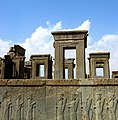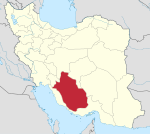Fars province: Difference between revisions
| Line 206: | Line 206: | ||
==External links== |
==External links== |
||
{{commons|Fars Province}} |
{{commons|Fars Province}} |
||
* [http://www.lovelyiran.com/fars/ Fars Tourist Attractions] |
|||
* [http://www.farsmiras.ir/ Cultural Heritage Foundation of Fars Province] |
* [http://www.farsmiras.ir/ Cultural Heritage Foundation of Fars Province] |
||
* [http://www.persepolis.ir Official website of Persepolis] |
* [http://www.persepolis.ir Official website of Persepolis] |
||
Revision as of 21:41, 14 March 2010
Template:Infobox Iran Province
Fārs (pronounced /fɑː(ɹ)s/ (Persian: Fārs, Pārs) (Originally Pars) is one of the 30 provinces of Iran. It is in the south of the country and its center is Shiraz. It has an area of 122,400 km². In 2006, this province had a population of 4.34 million people, of which 61.2% were registered as urban dwellers, 38.1% villagers, and 0.7% nomad tribes.[1]
Fars is the original homeland of the Persian people. The native name of the Persian language is Fârsi or Pârsi. Persia and Persian both derive from the Hellenized form Πέρσις Persis of the root word Pârs. The Old Persian word was Pârsâ.
Etymology
The word Fars is derived from 𐎱𐎠𐎼𐎿 Pârsa, the Old Persian name for Persia and its capital, Persepolis. Fars is the Arabized version of Pârs, as Arabic has no [p] phoneme.
History
Persis

The ancient Persians were present in the region from about the 9th century BC, and became the rulers of a large empire under the Achaemenid dynasty in the 6th century BC. The ruins of Persepolis and Pasargadae, two of the four capitals of the Achaemenid Empire, are located in Fars.
The Achaemenid Empire was defeated by Alexander III of Macedon in the fourth century BC. Shortly after this the Seleucid Empire was established. However it never extended its power beyond the main trade routes in Fars, and by reign of Antiochus I or possibly later Persis emerged as an independent state that minted its own coins.[2]

The Seleucid Empire was defeated by the Parthians in 238 BC. By 205 BC Antiochus III had extended his authority into Persis and it ceased to be an independent state.[3]
Babak was the ruler of a small town called Kheir. Babak's efforts in gaining local power at the time escaped the attention of Artabanus IV, the Arsacid Emperor of the time. Babak and his eldest son Shapur managed to expand their power over all of Persis.
The subsequent events are unclear, due to the sketchy nature of the sources. It is however certain that following the death of Babak around 220, Ardashir who at the time was the governor of Darabgird, got involved in a power struggle of his own with his elder brother Shapur. The sources tell us that in 222, Shapur was killed when the roof of a building collapsed on him.
At this point, Ardashir moved his capital further to the south of Persis and founded a capital at Ardashir-Khwarrah (formerly Gur, modern day Firouzabad).
After establishing his rule over Persis, Ardashir I rapidly extended his territory, demanding fealty from the local princes of Fars, and gaining control over the neighboring provinces of Kerman, Isfahan, Susiana, and Mesene.

Artabanus marched a second time against Ardashir I in 224. Their armies clashed at Hormizdeghan, where Artabanus IV was killed. He was crowned in 226 at Ctesiphon as the sole ruler of Persia; bringing the 400-year-old Parthian Empire to an end.
The Sassanids ruled for 425 years, until the Arab armies conquered the empire.
Iran
Fars then passed hand to hand through numerous dynasties, leaving behind numerous historical and ancient monuments; each of which has its own values as a world heritage, reflecting the history of the province, Iran, and western Asia. The ruins of Bishapur, Persepolis, and Firouzabad are all reminders of this.
For a better grasp of Iranian history and culture, the serial papers published in Etelaat Newspaper ( in Persian) by Mr. Hamid R. Dolatabadi could be of great help for the scholars.(7)
Administrative divisions
Fars is located in the south of Iran. It neighbours Bushehr Province to the west, Hormozgān Province to the south, Kerman and Yazd provinces to the east, Isfahan province to the north and Kohgiluyeh and Boyer-Ahmad Province to the northwest. According to the latest divisions, the province contains the following counties:

- Estahban
- Abadeh
- Eqlīd
- Bavanat
- Jahrum
- Darab
- Sepidan
- Shiraz
- Fasa
- Firouzabad
- Saadat Shahr
- Sarvestan
- Safashahr
- Mohr
- Kherameh
- Kazeroon
- Lar
- Lamerd
- Marvdasht
- Mamasani
- Khonj
- Neyriz
- Rostam

Climate and wildlife
There are three distinct climatic regions in the Fars Province. First, the mountainous area of the north and northwest with moderate cold winters and mild summers. Secondly, the central regions, with relatively rainy mild winters, and hot dry summers. The third region located in the south and southeast, has moderate winters with very hot summers. The average temperature of Shiraz is 16.8 °C, ranging between 4.7° and 29.2 °C.
The geographical and climatic variation of the province causes varieties of plants; consequently, variation of wildlife has been formed in the province. Additional to the native animals of the province, many kinds of birds migrate to the province every year.[4] Many kinds of ducks, storks and swallows migrate to this province in an annual parade.[4] The main native animals of the province are gazelle, deer, mountain wild goat, ram, ewe and many kinds of birds.[4]
The province of Fars includes many protected wildlife zones. The most important protected zones are as follows:
- Toot Siah (Black Berry) Hunt Forbidden Zone, which is located at the end of Boanat region.
- Basiran Hunt Forbidden Zone, which is located 4 kilometers south to Abadeh.
- Bambo National Park, which is located on the north of Shiraz.
- Estahban Forest Park ( Parke Jangaly), which is located on the outskirts of Touraj mountain.
- Hermoodlar Protected Zone, which is located east to larestan.[4]
Arjan Meadow (22 km²) and Lake Parishan (40 km²) are designated Wetlands of International Importance under the Ramsar convention.
Economy
Agriculture is of great importance in Fars. The major products include cereal (wheat and barley), citrus fruits, dates, sugar beets and cotton.
Fars has major petrochemical facilities, along with an oil refinery, a factory for producing tires, a large electronics industry, and a sugar mill.
Tourism is also a large industry in the province. UNESCO has designated an area in the province, called Arjan (known as Dasht e Arjan) as a biosphere reserve.
Demographics
Due to the geographical characteristics of Fars and its proximity to the Persian Gulf, Fars has long been a residing area for various Iranian People and Semites who were under the influence of Persian culture. However, the tribes of Fars including Qashqai Turks, Mamasani Lurs, Khamseh and Kohkiluyeh have kept their native and unique cultures and lifestyles which constitute part of the cultural heritage of Iran attracting many tourists. Shiraz (provincial capital of Fars) has one of the most famous kinds of wine in the world. There used to be a lot of wine factories in this city. After the Islamic revolution in 1979 due to an Islamic law all wine factories were shut down. The province has a population of 4.4 million approximately.
Transportation
Shiraz Airport is the main international airport of the province and the second in the country. The cities of Lar and Lamerd also have airports linking them with Shiraz and Tehran and nearby Persian Gulf countries such as the UAE and Bahrain. Shiraz is along the main route from Tehran to southern Iran.
Colleges and universities
The following major universities are located in Fars:
- Shiraz University of Medical Sciences
- Shiraz University
- Shiraz University of Technology
- Islamic Azad University of Abadeh
- Islamic Azad University of Arsanjan
- Islamic Azad University of Estahban
- Islamic Azad University of Eghlid
- Islamic Azad University of Jahrom
- Islamic Azad University of Sepidan
- Islamic Azad University of Shiraz
- Islamic Azad University of Fasa
- Islamic Azad University of Neyriz
- Islamic Azad University of Firouzabad
- Islamic Azad University of Kazerun
- Islamic Azad University of Larestan
- Islamic Azad University of Sarvestan
- Islamic Azad University of Marvdasht
- Fasa University of Medical Sciences
- Jahrom University of Medical Sciences
- Shiraz University of Applied Science and Technology
- University of Payam Noor
- Fasa Institution (Centre) of High Education
Notables from Fars
- Mansur Hallaj Persian Mystician,killed in 8th century AC.
- Saadi, writer, poet, born and died in Shiraz.
- Hafez, poet, born and died in Shiraz.
- Mulla Sadra was born in Shiraz.
- Christiane Amanpour's father is originally from Sarvestan, Fars.
- Sibawayh, one of the founders of Arabic grammar, died in Shiraz.
- Karim Khan, founder of the Zand dynasty.
- Lotf Ali Khan, the last ruler of the Zand dynasty.
- Dolatabadi has been wellknown as a scholar and author in Iranian Literature for the old and new generation of Iran.
- Ibn Muqaffa,or Ruzbeh Dadwayh, Persian writer and translator in 8th century AC.
- Zahra Kazemi, photographer, born in Shiraz.
- Ladan and Laleh Bijani, famous conjoined twins, born in Shiraz.
- Shāh Shuja', buried in Shiraz.
- Khwaju Kermani, buried in Shiraz.
- Asghar Shekari was born in Shiraz.
- Seyyed Zia'eddin Tabatabaee was born in Shiraz.
- Ibn Khafif, a 9th century sage, is buried in Shiraz.
- Molla Sadra ,philosopher.
- Sheikh Ruzbehan
- Professor Nezameddin Faghih [5][6]
- Afshin Ghotbi, Football Manager of Iranian National Team
- Meulana Shahin Shirazi,Persian Jewish poet and wiseman.
- Junayd Shirazi
- Mohsen Kadivar
- Ata'ollah Mohajerani was a representative of Shiraz in the Majlis.
- Saeed Emami
- Gholam Reza Azhari
- Siyyid Mírzá 'Alí-Muhammad, the Báb
Fars Province in poetry
| Fars: The ancient homeland of Persia. | |
|---|---|
|
روی گفتم که در جهان بنهم که نه بیرون پارس منزل هست "I decided to travel to the greater world, But I found that no place could be my house except Fars, | |
photo gallery
-
The Persepolis in Fars, Iran
See also
Dialects of Fars 7.Dolatabadi, Hamid (1998). Serial articles on the literature and languages of Iran. Etelaat Newspaper.Tehran- Iran
References
- ^ Cite error: The named reference
Census2006was invoked but never defined (see the help page). - ^ The Cambridge History of Iran, Vol. 3 (1), p. 299
- ^ The Cambridge History of Iran, Vol. 3 (1), p. 302
- ^ a b c d Iran fars-shiraz
- ^ Nezameddin Faghih
- ^ Nezameddin Faghih Books
External links
- Fars Tourist Attractions
- Cultural Heritage Foundation of Fars Province
- Official website of Persepolis
- Fars Chamber of Commerce
- Fars Regional Library of Science and Technology
- Fars Province Department of Planning and Management
- Shiraz Chamber of Commerce
- UNESCO Biosphere Reserve of Arjan
- Some folk-songs from the Fars Province sung by Shusha Guppy in the 1970s:
Silver Gun, Wheat Flower, The Stars in Heaven, On Top of The Hill, The Silken Handkerchief, My Beloved is Short, The Water Pipe, You Must Come to Me (ascribed to the Mamasani Tribe).



